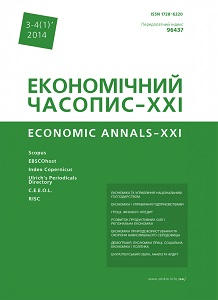REHABILITATION AUDIT: WHAT COAL MINES ARE TO BE INVESTED DURING THE ECONOMIC RECESSION?
REHABILITATION AUDIT: WHAT COAL MINES ARE TO BE INVESTED DURING THE ECONOMIC RECESSION?
Author(s): Maryna TereshchenkoSubject(s): Economy
Published by: Institute of Society Transformation
Keywords: coal-mining enterprise; state budget; investment attractiveness; restructuring; rehabilitation audit; cost; financial analysis
Summary/Abstract: Introduction. Under pressure of restricted public investments and low level of coal mines’ attractiveness, it is important to develop a strategy of defining what a coal mine is worth private investing and introducing a corporation management consistent with efficient extraction of available coal deposits. Therefore, any improvements in the decision making about investing a coal mine through rehabilitation audit are of high importance. The purpose is to develop approaches to rehabilitation audit acceptable for coal mining so that the later may be assessed by potential investors. Results. Thus, government owing coal mines may gradually improve their efficiency under pressure of restricted state budget donations only due to abandoning unprofitable sites and privatizing profitable entities. The most complicated task here is how to distinguish economically perspective and not perspective mines. More decisive approaches are needed to restructure current mining facilities. In addition, there is no benefit in the liquidation of some mines as the first step requires mines’ rehabilitation and modernization with further finding the most efficient mine sites. The rehabilitation audit is usually undertaken for those companies that suffer financial losses. The main criterion for making a decision about rehabilitation or abandoning a company is its rehabilitation ability. However, available approach to rehabilitation audit does not reflect all specifies of the mining industry, which has three main pillars – nature, technology and operations. So, we offer to use the term «the level of the rehabilitation attractiveness» of a mine. It is a quantitative dimension of system efficiency. Hence, we can draw the theory of a mine that is useless to be rehabilitated if the specific margin value of its efficiency, which shows its being not perspective, is found. It is necessary to define what conditions should be met so that the extraction of anthracite, which is difficult to be reached, is efficient compared to the alternative of abandoning these deposits not extracted. Considering costs as marginal monetary value is rational since this is a business outlook of an investor willing to establish a corporation and donate a mine. However, the coal extraction has a business perspective under complicated geological conditions if total costs to extract all deposits within a mine site are lower than the highest costs among other Ukrainian mines extracting coal of the same mark. Conclusion. The rehabilitation audit allows assessing a mine’s ability to return its debts, confirm its financial independence and consistency between available assets and business strategy. It was justified that the rehabilitation audit undertaken for mining sites implies corporate ownership of coal deposits and their extraction with lowering costs compared to the scenario if only one owner explores new mining sites with limited investment amount.
Journal: Економічний часопис - ХХІ
- Issue Year: 2014
- Issue No: 03-04(1)
- Page Range: 104-106
- Page Count: 3
- Language: English

